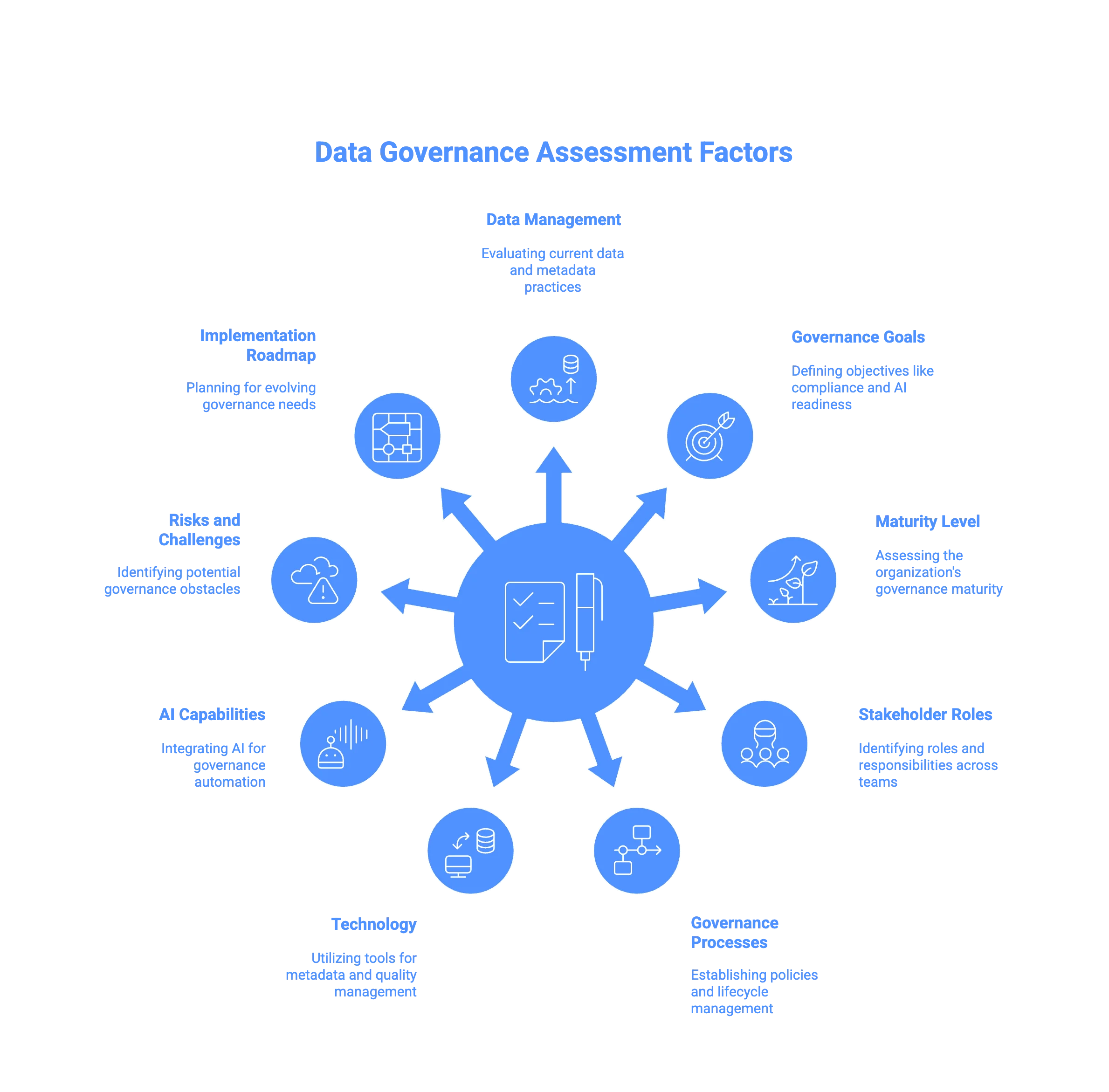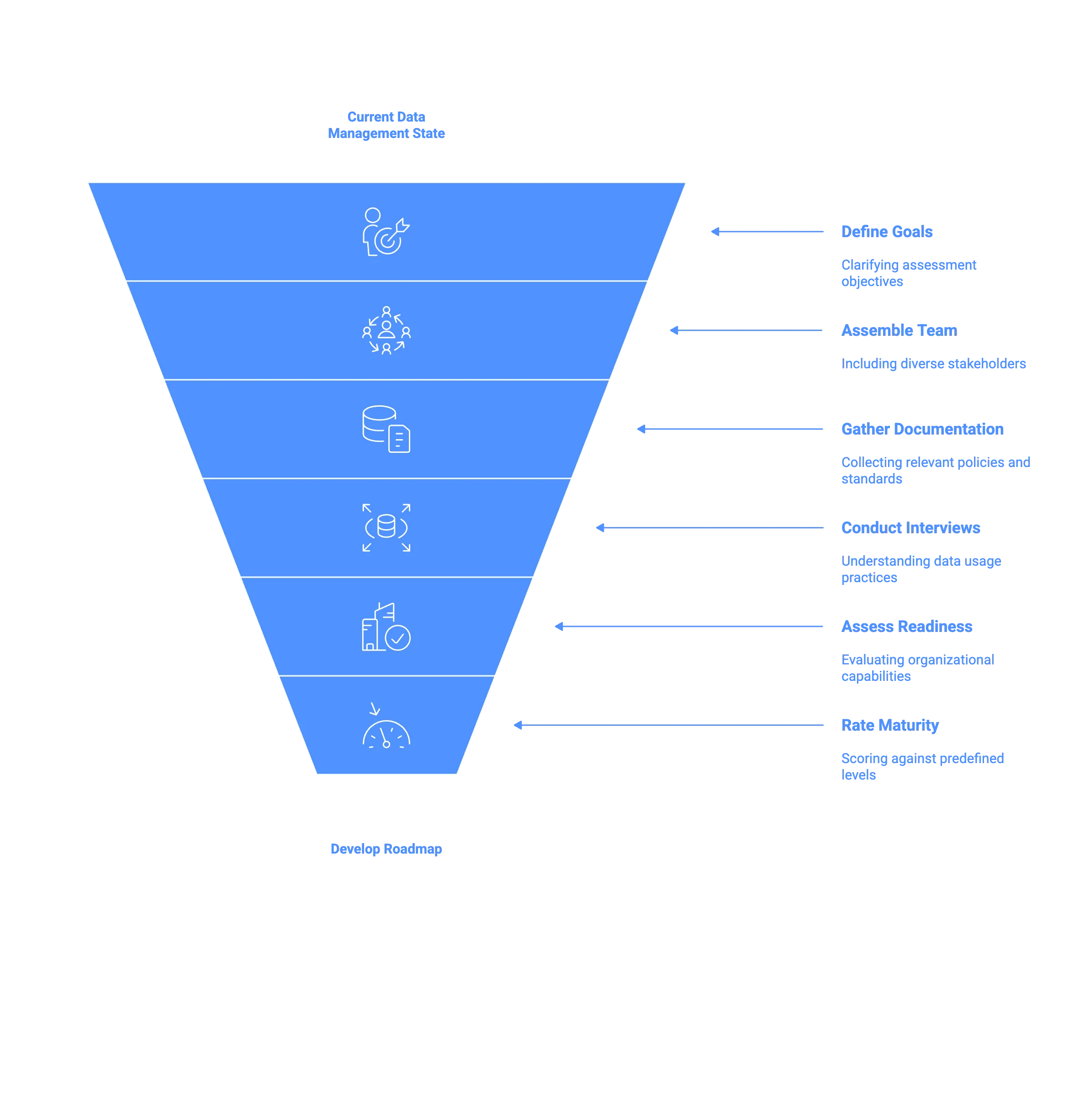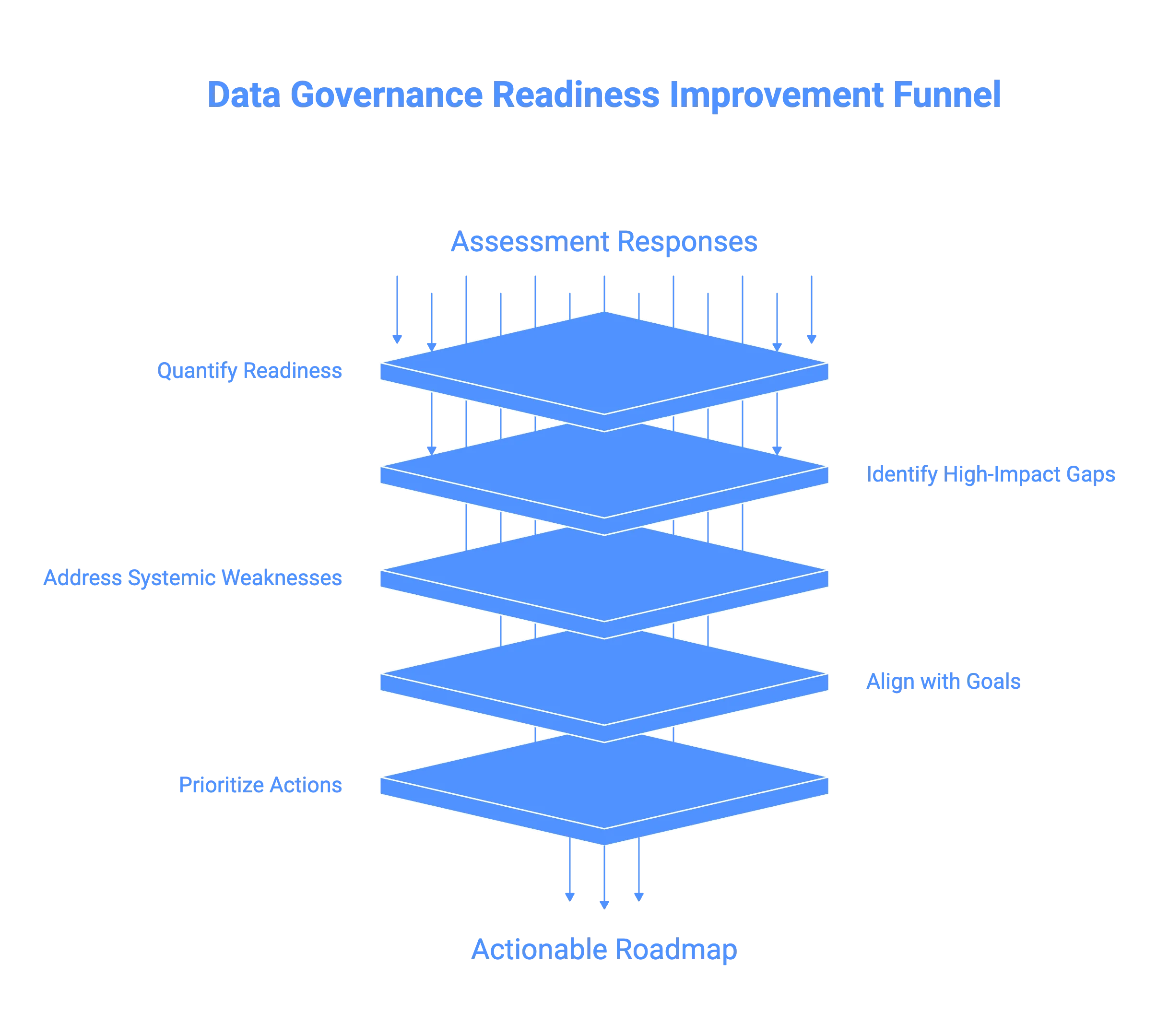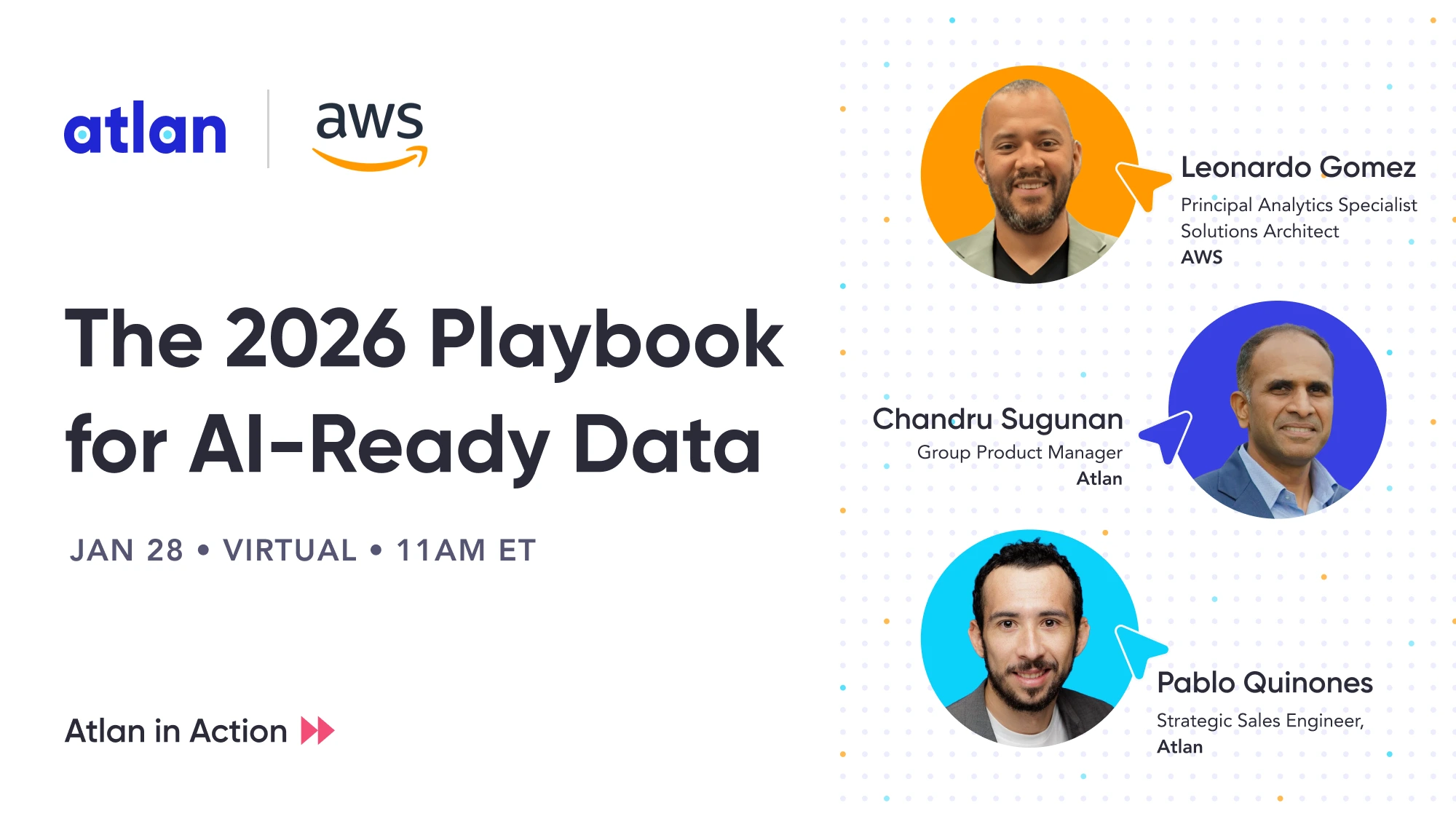Data Governance Readiness Assessment: Key Factors & How-To Guide [2025]
What are the key factors to consider for data governance readiness assessment?
Permalink to “What are the key factors to consider for data governance readiness assessment?”Summarize and analyze this article with 👉 🔮 Google AI Mode or 💬 ChatGPT or 🔍 Perplexity or 🤖 Claude or 🐦 Grok (X) .
A readiness assessment should evaluate your organization across these factors:
- Current state of data and metadata management
- Data governance goals and objectives, such as regulatory compliance, analytics enablement, or AI readiness
- Data governance maturity level, identifying strengths and weaknesses in their data management practices
- Stakeholders and their roles, responsibilities, and skills across teams
- Data governance processes for policy setting and enforcement, lifecycle management, etc.
- Data governance technology for metadata management, lineage tracking, quality monitoring, etc.
- AI and automation capabilities to operationalize governance for
- Data governance risks and challenges
- Implementation roadmap and change management as your needs evolve

Key factors for data governance readiness assessment - Image by Atlan.
Move from readiness to results—answer 12 quick questions and get your 90‑day governance roadmap.
What are the benefits of conducting a data governance readiness assessment?
Permalink to “What are the benefits of conducting a data governance readiness assessment?”A data governance readiness assessment is vital for any organization looking to maximize the value of its data assets and achieve its business objectives.
The readiness assessment can offer direct and indirect benefits, such as:
- Improved data quality: Helps identify and address data quality gaps to ensure accuracy, completeness, and reliability.
- Informed decision-making: Supports building a stronger data governance framework, which bolsters governance foundations so leaders can make decisions backed by trusted, reliable data.
- Alignment with business goals: Ensures governance practices are in sync with broader organizational objectives and strategic priorities.
- Cost savings: Efficient data governance reduces costly data errors, increases operational efficiency, and minimizes compliance penalties.
- Enhanced compliance and security: Evaluating compliance posture and risk management helps mitigate data-related risks and meet regulatory requirements.
Benchmark your governance maturity against peers and turn it into a 90‑day roadmap you can execute.
How to perform a data governance readiness assessment in 9 steps
Permalink to “How to perform a data governance readiness assessment in 9 steps”A structured approach ensures your readiness assessment delivers actionable insights. Here’s a step-by-step process:
- Assess the current state of data and metadata management: Use a structured evaluation to assess existing processes, workflows, and tools.
- Define goals and objectives: Clarify why you’re conducting the assessment (e.g., regulatory compliance, AI enablement, data quality). This will help you develop an effective data governance framework that’s unique to your requirements.
- Assemble your assessment team: Include data owners, stewards, governance leads, technical teams, and business stakeholders.
- Gather data and document it: Collect information on policies, standards, data inventories, lineage diagrams, and existing governance workflows.
- Conduct stakeholder interviews: Understand how different teams manage, access, and use data in practice.
- Assess organizational readiness: Evaluate your organization’s readiness to adopt a data governance framework. Assess culture, skill levels, resources, and the willingness of the organization to change.
- Rate maturity level: Score each factor against predefined maturity levels to identify strengths and weaknesses.
- Document risks and identify gaps: Note compliance risks, technical limitations, process inefficiencies, and AI governance challenges. Identify the gaps between the current state and the desired state of data governance.
- Develop recommendations and roadmap: Develop a roadmap to address high-impact gaps and track progress.

Key steps to conduct a data governance readiness assessment - Image by Atlan.
What is included in a data governance readiness assessment questionnaire?
Permalink to “What is included in a data governance readiness assessment questionnaire?”A structured assessment questionnaire ensures consistent, comparable input from stakeholders. It should cover all key factors listed above, using a mix of Yes/No, rating scale, and open-ended questions.
Here are some essential questions you need to ask.
Section 1: Current state of data management
Permalink to “Section 1: Current state of data management”- [ ] Do we have a defined process for data collection, storage, processing, and usage? (Yes/No)
- [ ] Is there a consistent understanding of data definitions, data usage, and data ownership within the organization? (Yes/No)
- [ ] Do we maintain a centralized metadata repository? (Yes/No)
- [ ] Is our metadata accurate, complete, and regularly updated? (Yes/No)
- [ ] Are all data assets consistently classified and tagged? (Yes/No)
Section 2: Goals and objectives of data governance
Permalink to “Section 2: Goals and objectives of data governance”- [ ] Have we clearly defined our goals and objectives for implementing a data governance framework? (Yes/No)
- [ ] Do our objectives align with overall business strategy and objectives? (Yes/No)
- [ ] Which primary driver applies to us? (Regulatory compliance / AI readiness / Data quality / Other)
Section 3: Assessment team and ownership
Permalink to “Section 3: Assessment team and ownership”- [ ] Have we identified key stakeholders who will be involved in the data governance program? (Yes/No)
- [ ] Do we have the support of top management for implementing data governance? (Yes/No)
- [ ] Are both business and technical stakeholders represented in governance decisions? (Yes/No)
Section 4: Documentation
Permalink to “Section 4: Documentation”- [ ] Do we have up-to-date data policies and standards? (Yes/No)
- [ ] Is there an enterprise-wide data catalog? (Yes/No)
- [ ] Do we maintain current lineage diagrams for critical datasets? (Yes/No)
- [ ] Have we documented our current data quality management practices? (Yes/No)
Section 5: Stakeholder interviews
Permalink to “Section 5: Stakeholder interviews”- [ ] How do you currently access data for your role? (Open-ended)
- [ ] What challenges do you face when finding or trusting data? (Open-ended)
- [ ] Do you have access to AI-assisted tools for data search, discovery, or analysis? (Yes/No)
Section 6: Organizational readiness
Permalink to “Section 6: Organizational readiness”- [ ] Are we culturally prepared to embrace the changes brought about by data governance? (Yes/No)
- [ ] Do we have adequate resources (budget, staff, tools) to support governance? (Yes/No)
- [ ] Are teams trained to use AI and automation in governance workflows? (Yes/No)
Section 7: Data governance maturity level
Permalink to “Section 7: Data governance maturity level”- [ ] Have we assessed our data governance maturity level using a standard model? (Yes/No)
- [ ] Does it measure our maturity in terms of data quality management processes, data lineage, metadata infrastructure, automation and AI, and compliance readiness? (Yes/No)
- [ ] Are we aware of the gaps and areas that need improvement in our current data governance practice? (Yes/No)
Section 8: Risk and challenges identification
Permalink to “Section 8: Risk and challenges identification”- [ ] Have we identified potential risks and challenges in implementing a data governance program? (Yes/No)
- [ ] Are there known blind spots in data lineage, quality, policy enforcement, or metadata coverage? (Yes/No)
- [ ] What governance-related incidents or audit findings have occurred in the past year? (Open-ended)
- [ ] Do we have a mitigation plan in place for identified risks and challenges? (Yes/No)
Section 9: Recommendations and roadmap
Permalink to “Section 9: Recommendations and roadmap”- [ ] Have we defined clear responsibilities, timelines, and metrics for our data governance program? (Yes/No)
- [ ] Which gaps should we address in the next 3–6 months? (Open-ended)
- [ ] What governance improvements would have the highest impact? (Open-ended)
- [ ] Which AI-driven capabilities should we prioritize for the next phase? (Open-ended)
- [ ] Do we have a process in place for continuous assessment of our data governance program? (Yes/No)
For each Yes/No question:
- A “Yes” signals readiness in that area and a foundation to build on.
- A “No” highlights a gap that needs to be addressed before fully rolling out your data governance program.
Every “No” should trigger a deeper discussion on the root cause, potential risks, and the resources or changes needed to shift it to a “Yes.”
How should you interpret the results of your data governance readiness assessment?
Permalink to “How should you interpret the results of your data governance readiness assessment?”Interpreting the assessment questionnaire responses involves spotting patterns, quantifying readiness, and identifying the biggest opportunities for impact.
Here’s how you can interpret the results:
1. Quantify your readiness score: Assign numeric values to Yes/No answers (e.g., Yes = 1, No = 0) and average them across each section. This creates a readiness score per factor (e.g., metadata management, AI readiness, compliance).
What is a good readiness score? A score above 80% usually signals strong readiness, while anything below 50% indicates critical gaps.
Note: A low readiness score can act as a roadmap too. The insights help you close gaps methodically and prepare for governance at scale, including AI-powered governance workflows.
2. Look for high-impact “No” answers: One “No” in areas like regulatory compliance, data quality, lineage, or AI governance can be a bigger risk than multiple smaller gaps. Flag these for immediate follow-up.
3. Identify systemic weaknesses: If several sections score low—especially those related to metadata accuracy, ownership, or change management—it often points to deeper cultural or organizational challenges.
How can you improve your organization’s data culture?
- Launch a series of workshops or seminars demonstrating the value and importance of well-governed data.
- If stakeholder engagement is the problem, then consider regular communication about the data governance program, training sessions, and feedback opportunities.
4. Map maturity against your goals: Compare results with your stated governance objectives (e.g., enabling AI use cases, meeting regulatory deadlines). You may find your current maturity is sufficient for some goals but not others.
Note: Goals should be Specific, Measurable, Achievable, Relevant, and Time-bound (SMART).
5. Prioritize quick wins and strategic investments: Some gaps can be closed with simple process changes, while others may require investment in tools (e.g., active metadata platforms, lineage automation) or skills development.
6. Develop an actionable roadmap: Cover how and when each element of your data governance program will be rolled out. Include who is responsible for each task, and how progress will be tracked and measured.
7. Reassess regularly: Treat this as a living baseline. Re-run the assessment quarterly or bi-annually to measure progress and adjust your roadmap.

How to interpret the results of your data governance readiness assessment - Image by Atlan.
How do modern data teams improve their data governance readiness profiles?
Permalink to “How do modern data teams improve their data governance readiness profiles?”Improving your readiness profile means closing the gaps identified in your assessment and future-proofing governance to handle evolving regulatory, business, and AI demands.
The first step is to build a metadata foundation for your organization, which will improve your automation and AI-readiness.
Future-forward data teams unify metadata in a single platform like Atlan. Atlan helps you down silos by consolidating metadata from all sources into a central, active repository for consistent governance.
Data governance area | Before Atlan | After Atlan |
|---|---|---|
Metadata management | Metadata scattered across tools, systems, and teams | Unified, active metadata control plane |
Workflow automation | Manual, time-consuming and error-prone | AI-driven automation for data classification, lineage tracking, quality monitoring, and policy enforcement |
Data definitions | Inconsistent or missing definitions | Standardized business glossary that mirrors your business domains. |
Data governance policies | Ad-hoc policies with inconsistent enforcement. | Automated enforcement of standardized, enterprise-wide policies. Also, a transparent dashboard that monitors top-down coverage across your data estate in real time. |
Data lineage | Incomplete data lineage without frequent updates | Real-time, actionable, active and automated data lineage with column-level detail. |
Data quality | Reactive, with limited monitoring | Proactive monitoring, automated data quality checks, AI-assisted anomaly detection, and more. |
Governance integration | Governance is an afterthought, an extra step. | Governance is embedded in your daily workflows–tools you already use (e.g., Jira, Slack, BI dashboards)–for frictionless adoption. |
Real stories from real customers: Automating and scaling data governance
Permalink to “Real stories from real customers: Automating and scaling data governance”
Modernized data stack and launched new products faster while safeguarding sensitive data
“Austin Capital Bank has embraced Atlan as their Active Metadata Management solution to modernize their data stack and enhance data governance. Ian Bass, Head of Data & Analytics, highlighted, ‘We needed a tool for data governance… an interface built on top of Snowflake to easily see who has access to what.’ With Atlan, they launched new products with unprecedented speed while ensuring sensitive data is protected through advanced masking policies.”

Ian Bass, Head of Data & Analytics
Austin Capital Bank
🎧 Listen to podcast: Austin Capital Bank From Data Chaos to Data Confidence
See how Atlan can help implement data governance for AI
Book a Personalized Demo →
53 % less engineering workload and 20 % higher data-user satisfaction
“Kiwi.com has transformed its data governance by consolidating thousands of data assets into 58 discoverable data products using Atlan. ‘Atlan reduced our central engineering workload by 53 % and improved data user satisfaction by 20 %,’ Kiwi.com shared. Atlan’s intuitive interface streamlines access to essential information like ownership, contracts, and data quality issues, driving efficient governance across teams.”
Data Team
Kiwi.com
🎧 Listen to podcast: How Kiwi.com Unified Its Stack with Atlan

One trusted home for every KPI and dashboard
“Contentsquare relies on Atlan to power its data governance and support Business Intelligence efforts. Otavio Leite Bastos, Global Data Governance Lead, explained, ‘Atlan is the home for every KPI and dashboard, making data simple and trustworthy.’ With Atlan’s integration with Monte Carlo, Contentsquare has improved data quality communication across stakeholders, ensuring effective governance across their entire data estate.”

Otavio Leite Bastos, Global Data Governance Lead
Contentsquare
🎧 Listen to podcast: Contentsquare’s Data Renaissance with Atlan
Join Data Leaders Scaling with Automated Data Governance
Book a Personalized Demo →Ready to improve your data governance readiness?
Permalink to “Ready to improve your data governance readiness?”A data governance readiness assessment is your blueprint for building a governance program that works today and adapts tomorrow.
By understanding your current state, defining clear goals, and closing gaps across people, processes, and technology, you set the stage for compliant, AI-ready, and value-driven data practices.
With a unified, active metadata control plane like Atlan, modern teams can operationalize governance seamlessly, embed it into daily workflows, and unlock trust and innovation in every data-driven decision.
Discover how a modern data governance platform drives real results - Book a personalised demo
Discover how a modern data governance platform drives real results
Book a Personalized Demo →FAQs about data governance readiness assessment
Permalink to “FAQs about data governance readiness assessment”1. What is a data governance readiness assessment?
Permalink to “1. What is a data governance readiness assessment?”A data governance readiness assessment measures how prepared an organization is to implement or scale a data governance program.
It examines various aspects, including data management practices, governance goals, and maturity levels.
2. What key components should be included in a data governance readiness assessment?
Permalink to “2. What key components should be included in a data governance readiness assessment?”Key components include evaluating current data management practices, defining governance goals, assessing maturity levels, identifying risks, and developing a roadmap for implementation.
3. What is the purpose of a data governance readiness assessment?
Permalink to “3. What is the purpose of a data governance readiness assessment?”It evaluates how prepared your organization is to implement or scale a data governance program, helping you identify gaps, risks, and opportunities.
4. Who should participate in the readiness assessment?
Permalink to “4. Who should participate in the readiness assessment?”Key stakeholders, including data owners, stewards, governance leads, compliance officers, technical teams, and business users who rely on data for decision-making.
5. How long does a readiness assessment take?
Permalink to “5. How long does a readiness assessment take?”Depending on scope and complexity, it can take anywhere from a few weeks to several months, especially if involving multiple departments and geographies.
6. What are common challenges faced during a data governance readiness assessment?
Permalink to “6. What are common challenges faced during a data governance readiness assessment?”Common challenges include resistance to change, lack of skilled personnel, budget constraints, and difficulties in aligning governance practices with organizational culture. Addressing these challenges requires a well-planned strategy and stakeholder involvement.
7. How often should we run a data governance readiness assessment?
Permalink to “7. How often should we run a data governance readiness assessment?”Most organizations reassess annually or bi-annually, or before launching major initiatives like AI deployments, mergers, or regulatory compliance projects.
8. How does AI factor into the readiness assessment?
Permalink to “8. How does AI factor into the readiness assessment?”Modern assessments now measure AI readiness, including whether metadata, lineage, and governance workflows can support AI and automation at scale.
9. What tools help improve readiness after the assessment?
Permalink to “9. What tools help improve readiness after the assessment?”Active metadata platforms like Atlan centralize metadata, automate lineage and quality checks, and embed governance into everyday tools like Jira, Slack, and BI dashboards.
Share this article
Atlan is the next-generation platform for data and AI governance. It is a control plane that stitches together a business's disparate data infrastructure, cataloging and enriching data with business context and security.
Data governance readiness assessment: Related reads
Permalink to “Data governance readiness assessment: Related reads”- Data Governance in Action: Community-Centered and Personalized
- Data Governance Tools: Importance, Key Capabilities, Trends, and Deployment Options
- Data Governance Tools Comparison: How to Select the Best
- Data Governance Tools Cost: What’s The Actual Price?
- Data Governance Process: Why Your Business Can’t Succeed Without It
- Data Governance and Compliance: Act of Checks & Balances
- Data Compliance Management: Concept, Components, Getting Started
- Data Governance for AI: Challenges & Best Practices
- A Guide to Gartner Data Governance Research: Market Guides, Hype Cycles, and Peer Reviews
- Gartner Data Governance Maturity Model: What It Is, How It Works
- Data Governance Maturity Model: A Roadmap to Optimizing Your Data Initiatives and Driving Business Value
- Data Governance vs Data Compliance: Nah, They Aren’t The Same!
- Data Governance in Banking: Benefits, Implementation, Challenges, and Best Practices
- Open Source Data Governance - 7 Best Tools to Consider in 2025
- Federated Data Governance: Principles, Benefits, Setup
- Data Governance Committee 101: When Do You Need One?
- Data Governance for Healthcare: Challenges, Benefits, Core Capabilities, and Implementation
- Data Governance in Hospitality: Challenges, Benefits, Core Capabilities, and Implementation
- 10 Steps to Achieve HIPAA Compliance With Data Governance
- Snowflake Data Governance — Features, Frameworks & Best practices
- Data Governance Roles and Responsibilities: A Round-Up
- Data Governance Policy: Examples, Templates & How to Write One
- Data Governance Framework: Examples, Template & How to Create one?
- 7 Best Practices for Data Governance to Follow in 2025
- Benefits of Data Governance: 4 Ways It Helps Build Great Data Teams
- Key Objectives of Data Governance: How Should You Think About Them?
- The 3 Principles of Data Governance: Pillars of a Modern Data Culture























